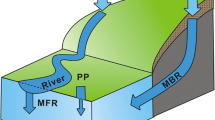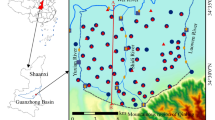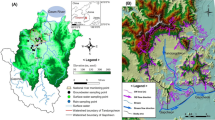Abstract
In Taiwan’s humid climate, proximal fan groundwater (PFG) is mainly sourced from local precipitation (LP), mountain front recharge (MFR), and mountain block recharge (MBR). This study evaluates the relative importance of the above sources’ respective contributions to the PFG of the Langyang alluvial plain (LAP), northeastern Taiwan. To this end, we first identify stable isotopic characteristics of these target waters and evaluate the hydrological relations among them. Further, we employ ternary end member mixing analysis (EMMA) based on δ 18O and electrical conductivity to semi-quantitatively calculate contributing fractions and amounts of water for respective LP, MFR, and MBR end members. EMMA results indicate that the respective contribution fractions of LP, MFR, and MBR to PFG at the LAP are approximately 28, 60, and 12 %, respectively. Further, we employ the obtained contribution fractions to understand the corresponding water amounts of each end-member contributed to PFG. In total, 325 × 106 m3 of water recharges PFG annually; of which, 226 × 106 m3/yr. is from MFR, 76 × 106 m3/yr. from LP, and 23 × 106 m3/yr. from MBR. MFR is clearly the greatest source of water at the LAP and local water resource management and protection authorities should concentrate their energies on this important contributor to groundwater. To keep these results in context, limitations to the EMMA approach are evaluated in the text.




Similar content being viewed by others
References
Ajami HA, Troch PA, Maddock IIIT, Meixner T, Eastoe C (2011) Quantifying mountain block recharge by means of catchment-scale storage-discharge relationships. Water Resour Res 47:W04504. doi:10.1029/2010WR009598
Appelo CAJ, Postma D (1996) Geochemistry, groundwater and pollution. Balkema, Rotterdam, pp. 142–174
Banks EW, Simmons CT, Love AJ, Shand P (2011) Assessing spatial and temporal connectivity between surface water and groundwater in a regional catchment: implication for regional scale water quantity and quality. J Hydrol 404:93–102. doi:10.1016/j.jhydrol.2011.04.017
Barth JAC, Stichler W, Bergemann M, Reincke H (2006) Can conductivity and stable isotope tracers determine water sources during flooding? An example from the Elbe River in 2002. Int J River Basin Manag 4(2):77–83. doi:10.1080/15715124.2006.9635278
Barthold FK, Tyralla C, Schneider K, Vache KB, Frede H, Breuer L (2011) How many tracers do we need for end member mixing analysis (EMMA)? A sensitivity analysis. Water Resour Res 47:W08519. doi:10.1029/2011WR010604
Beniston M, Stoffel M (2014) Assessing the impacts of climatic change on mountain water resources. Sc Total Environ 493:1129–1137. doi:10.1016/j.scitotenv.2013.11.122
Berendsen HJC (2011) Errors: classification and propagation. In: A Student’s guide to data and error analysis. Cambridge University Press, New York, pp. 18–26. doi:10.1017/CBO9780511921247.004
Bosley KL, Witting DA, Chambers R, Wainright SC (2002) Estimating turnover rates of carbon and nitrogen in recently metamorphosed winter flounder (Pseudopleuronectes americanus) with stable isotopes. Mar Ecol Prog 236:233–240. doi:10.3354/meps236233
Bowen EE, Hamada Y, O’Connor BL (2014) Mapping mountain front recharge areas in arid watersheds based on a digital elevation model and land cover types. J Water Resour Protec 6:756–771. doi:10.4236/jwarp.2014.68072
Brunner P, Cook PG, Simmons CT (2011) Disconnected surface water and groundwater: from theory to practice. Ground Water 49:460–467. doi:10.1111/j.1745-6584.2010.00752.x
Central Geological Survey (1995) Explanatory text of the geologic map of Sanshin (1:50,000). Ministry of Economic Affairs, Taipei, Taiwan
Central Geological Survey (2013) Hydrogeological investigation and groundwater recharge model simulations: recharge areas delineation and groundwater resources assessment (1/4). Ministry of Economic Affairs, Taipei, Taiwan
Central Weather Bureau (1981–2010) Monthly Precipitation – Ilan. http://www.cwb.gov.tw/V7/climate/monthlyMean/Taiwan precp.htm ; accessed on 1 June 2015.
Chang CC (1995) Groundwater study of the Ilan area. PhD Thesis of National Taiwan Normal University, Taipei, Taiwan, pp. 259.
Cheng YC (2010) The paleoenvironment analysis of the Ilan plain. Master’s Thesis of National Taiwan Ocean University, Keelung, Taiwan, p. 75
Clark ID, Fritz P (1997) Tracing the hydrological cycle. In: Environmental isotopes in hydrogeology. CRC Press, Florida, pp. 35–60
Dor N, Syafalni S, Abustan I, Rahman MTA, Nazri MAA, Mostafa R, Mejus L (2011) Verification of surface-groundwater connectivity in an irrigation canal using geophysical, water balance and stable isotope approaches. Water Resour Manage 25:2837–2853. doi:10.1007/s11269-011-9841-y
Ebrahimi H, Ghazavi R, Karimi H (2016) Estimation of groundwater recharge from the rainfall and irrigation in an arid environment using inverse modeling approach and RS. Water Resour Manage 30:1939–1951. doi:10.1007/s11269-016-1216-6
Genereux D (1998) Quantifying uncertainty in tracer-based hydrograph separations. Water Resour Res 34(4):915–919. doi:10.1029/98WR00010
Irmak S, Haman DZ, Jones JW (2002) Evaluation of class a pan coefficients for estimating reference evapotranspiration in humid location. J Irrig Drain Eng 128(3):249–253. doi:10.1061/(ASCE)0733-9437(2002)128:3(153)
Kambhammettu BVNP, King JP, Allena P (2011) Evaluation of mountain-front recharge estimation techniques for southern New Mexico basins. Int J Water Res Environ Eng 3(3):66–72
Kao YH, Liu CW, Wang SW, Lee CH (2012) Estimating mountain block recharge to downstream alluvial aquifers from standard methods. J Hydrol 426–427:93–102. doi:10.1016/j.jhydrol.2012.01.016
Lis G, Wassenaar LI, Hendry MJ (2008) High-precision laser spectroscopy D/H and 18O/16O measurements of microliter natural water samples. Anal Chem 80:287–293. doi:10.1021/ac701716q
Liu Y, Yamanaka T (2012) Tracing groundwater recharge sources in a mountain–plain transitional area using stable isotopes and hydrochemistry. J Hydrol 464-465:116–126. doi:10.1016/j.jhydrol.2012.06.053
Liu KK, Yui TF, Shieh YN, Chiang SC, Chen LH, Hu JY (1990) Hydrogen and oxygen isotopic compositions of meteoric and thermal waters from the Chingshui geothermal area, northeastern Taiwan. Proc Geol Soc China 33(2):143–165
Liu Y, Leng X, Deng Z, Wang L, Zhang L, Liu S, An S (2011) Effects of watershed vegetation on tributary water yields during the wet season in the Heishui Valley, China. Water Resour Manage 25:1449–1464. doi:10.1007/s11269-010-9754-1
Mas-Pla J, Menció A, Marsiñach A (2013) Basement groundwater as a complementary resource for overexploited stream-connected alluvial aquifers. Water Resour Manage 27:293–308. doi:10.1007/s11269-012-0186-y
Maurya AS, Shah M, Deshpande RD, Bhardwaj RM, Prasad A, Gupta SK (2011) Hydrograph separation and precipitation source identification using stable water isotopes and conductivity: river ganga at Himalayan foothills. Hydrol Proc 25:1521–1530. doi:10.1002/hyp.7912
Panichi C, Gonfiantini R (1981) Geothermal waters. In: Gat J R, Gonfiantini R (eds) Stable isotope hydrology: deuterium and oxygen–18 in the water cycle. International Atomic Energy Agency Technical Report 210, Vienna, pp. 241–271.
Peng TR, Wang CH, Huang CC, Fei LY, Chen CTA, Hwong JL (2010) Stable isotopic characteristic of Taiwan’s precipitation: a case study of western Pacific monsoon region. Earth Planet Sc Lett 289:357–366. doi:10.1016/j.epsl.2009.11.024
Peng TR, Liu KK, Wang CH, Chuang KS (2011) A water isotope approach to assessing moisture recycling in the island-based precipitation of Taiwan: a case study in the western Pacific. Water Resour Res 47:W08507. doi:10.1029/2010WR009890
Peng TR, Lu WC, Chen KY, Zhan WJ, Liu TK (2014) Groundwater-recharge connectivity between a hills-and-plains’ area of western Taiwan using water isotopes and electrical conductivity. J Hydrol 517:226–235. doi:10.1016/j.jhydrol.2014.05.010
Phillips DL, Gregg JW (2001) Uncertainty in source partitioning using stable isotopes. Oecologia 127:171–179. doi:10.1007/s004420000578
Ping J, Nichol C, Wei X (2014) Quantification of groundwater recharge using the chloride mass balance method in a semi-arid mountain terrain, south interior British Columbia, Canada. J Chem Pharm Res 6(1):383–388
Smerdon BD, Allen DM, Grasby SE, Berg MA (2009) An approach for predicting groundwater recharge in mountainous watersheds. J Hydrol 365:156–172. doi:10.1016/j.jhydrol.2008.11.023
Snyder RL, Orang M, Matyac S, Grismer ME, M ASCE (2005) Simplified estimation of reference evapotranspiration from pan evaporation data in California. J Irrig Drain Eng 131 (3): 249–253. doi:10.1061/(ASCE)0733-9437(2005)131:3(249).
Vanderzalm JL, Jeuken BM, Wischusen JDH, Pavelic P, Le Gal La Salle C, Knapton A, Dillon PJ (2011) Recharge sources and hydrogeochemical evolution of groundwater in alluvial basins in arid Central Australia. J Hydrol 397:71–82. doi:10.1016/j.jhydrol.2010.11.035
Viviroli D, Archer DR, Buytaert W, Fowler HJ, Greenwood GB, Hamlet AF, Huang Y, Koboltschnig G, Litaor MI, L’opez-Moreno JI, Lorentz S, Schädler B, Schreier H, Schwaiger K, Vuille M, Woods R (2011) Climate change and mountain water resources: overview and recommendations for research, management and policy. Hydrol Earth Syst Sc 15:471–504. doi:10.5194/hess-15-471-2011
Water Resources Agency (2003) Groundwater resources maps of Taiwan. Ministry of Economic Affairs, Taipei, Taiwan
Wilson JL, Guan H (2004) Mountain block hydrology and mountain front recharge. In: Hogan JF, Phillips FM, Scanlon BR (eds) Groundwater recharge in a desert environment: the southwestern United States. American Geophysical Union, Washington, D. C.. doi:10.1029/009WSA08
Acknowledgments
The authors are very grateful to anonymous reviewers and the Associate Editor for their constructive comments, which greatly improved our manuscript. Work on this paper is divided into two parts. That focusing on meteoric water is an achievement attributable to assistance from the National Science Council, Taiwan (NSC 101-2116-M-005-001 and NSC 102-2116-M-005-001) and that regarding groundwater is attributable to assistance from the Central Geological Survey, Ministry of Economic Affairs, Taiwan (B10249).
Author information
Authors and Affiliations
Corresponding author
Appendix
Appendix
Table listing stable isotopic composition and EC concentration of mountain groundwaters (MBR water) represented by MGN and MGS waters of this study
MBR water | Sample site | δ 18O | δ 2H | EC | Sampling date |
|---|---|---|---|---|---|
(‰) | (‰) | (μS/cm) | |||
MGN | Well-1 | −8.5 | −50.9 | 962 | August 2006 |
Well-2 | −8.4 | −50.1 | 948 | August 2006 | |
Well-3 | −8.4 | −51.8 | 952 | August 2006 | |
Well-4 | −8.5 | −50.0 | 943 | August 2006 | |
Well-5 | −8.2 | −48.7 | 928 | August 2006 | |
Well-1 | −8.6 | −49.4 | 951 | November 2006 | |
Well-2 | −8.5 | −51.4 | November 2006 | ||
Well-3 | −8.4 | −49.8 | 1005 | November 2006 | |
Well-4 | −8.3 | −49.0 | 922 | November 2006 | |
Well-5 | −8.2 | −49.5 | 953 | November 2006 | |
Well-6 | −8.1 | −50.2 | 975 | November 2006 | |
Well-7 | −8.3 | −47.5 | 973 | November 2006 | |
Well-8 | −8.3 | −48.3 | 917 | November 2006 | |
Well-1 | −8.2 | −49.4 | March 2007 | ||
Well-2 | −8.2 | −54.0 | March 2007 | ||
Well-3 | −8.4 | −49.1 | March 2007 | ||
Well-4 | −8.5 | −42.7 | March 2007 | ||
Well-5 | −8.3 | −55.6 | March 2007 | ||
Well-6 | −8.3 | −49.9 | March 2007 | ||
Well-7 | −8.2 | −49.1 | March 2007 | ||
Well-8 | −8.2 | −52.8 | March 2007 | ||
Well-1 | −8.0 | −43.1 | 882 | July 2007 | |
Well-2 | −8.3 | −48.5 | 939 | July 2007 | |
Well-3 | −8.2 | −43.1 | 964 | July 2007 | |
Well-4 | −8.2 | −50.1 | 993 | July 2007 | |
Well-5 | −8.0 | −40.6 | 947 | July 2007 | |
Well-6 | −8.3 | −44.3 | 976 | July 2007 | |
Well-7 | −8.0 | −46.9 | 924 | July 2007 | |
Well-8 | −8.2 | −50.1 | 973 | July 2007 | |
Well-9 | −8.2 | −49.8 | 1354 | July 2013 | |
Mean | −8.3 | −48.9 | 971 | ||
MGS | Spring-1 | −6.0 | −40.0 | December 1991 | |
Spring-1 | −5.4 | −47.9 | March 1992 | ||
Spring-1 | −5.8 | −46.5 | July 1992 | ||
Spring-1 | −5.4 | −45.7 | November 1992 | ||
Spring-1 | −5.2 | −45.8 | February 1993 | ||
Spring-1 | −5.1 | −42.1 | May 1993 | ||
Spring-1 | −5.3 | −41.7 | August 1993 | ||
Spring-1 | −5.3 | −46.4 | November 1993 | ||
Spring-1 | −5.3 | −34.8 | January 1994 | ||
Spring-1 | −5.4 | −47.6 | February 1994 | ||
Spring-1 | −5.0 | −46.6 | 3710 | July 2013 | |
Spring-1 | −5.6 | −45.8 | 3160 | November 2013 | |
Mean | −5.4 | −44.2 | 3435 |
Rights and permissions
About this article
Cite this article
Peng, TR., Huang, CC., Chen, JE. et al. Evaluating the Relative Importance of Groundwater Recharge Sources in a Subtropical Alluvial Plain Using Tracer-Based Ternary End Member Mixing Analysis (EMMA). Water Resour Manage 30, 3861–3878 (2016). https://doi.org/10.1007/s11269-016-1393-8
Received:
Accepted:
Published:
Issue Date:
DOI: https://doi.org/10.1007/s11269-016-1393-8




